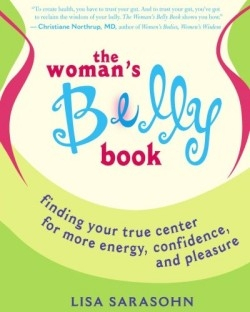The Woman's Belly Book
Finding Your True Center for More Energy Confidence and Pleasure
No woman living in the twenty-first century can ignore the constant barrage of images touting six-pack abs and never-too-thin bodies. This book will help counter this tsunami of propaganda.
At the outset, the author adamantly insists that this isn’t a self-improvement program. Rather than striving for some mythically perfect body/mind state, Sarasohn’s book is “about discovering, affirming, and being true to who you already are.” Since the belly encompasses the breathing apparatus, digestive tract, and sexual organs, the author believes that belly pride begins by valuing the belly as the center of a woman’s physical being, and the source of her creative power.
The book is divided into three main sections, all of which include exercises, either physical or non-physical. Section one helps a woman befriend her belly through core principles and practices, discusses cultural perceptions of the belly, and explains some basic anatomy. Section two explores the belly using the seven chakras (energy centers that line up on the vertical axis of the body) as starting points. Section three helps the reader design a personal practice that she can fit into her life, and discusses her connection to the greater world. An index, bibliography, resource list, and two appendices round out the volume.
This book works well because Sarasohn’s insights and exercises are grounded in experience and practice. She developed much of her approach in the workshops she teaches for women on belly awareness. As a Kripalu yoga teacher and a bodywork therapist, she emphasizes the importance of proper breathing, focusing on what she calls “centering breath” in her exercises. And she sees belly laughs as one type of exercise: did you hear about the guy whose Viagra got stuck in his throat last night? “Nothing much happened, but this morning he woke up with a stiff neck.”
The author’s writing is concise and engaging throughout. She explains anatomical and physiological principles clearly, without medical jargon. Her cultural and historical research brings up much fascinating information. For example, in seventeenth-century Europe, a large belly was a sign of beauty. Corsets arrived during the Victorian era, but the real turn to thin bellies didn’t occur until women got the vote in England and America. Another interesting point is Sarasohn’s challenge to the widely held belief that one can never do too many crunches or sit-ups. In fact, she asserts, overdoing them can unduly flatten the lower spine, causing injury.
It would be unrealistic to say that this one book will overturn modern culture’s toxic views on women’s bellies. But the author has certainly made a step in the right direction. With eating disorders at epidemic proportions (twenty-five million cases in the United Sates), Sarasohn’s approach comes not a minute too soon.
Reviewed by
Leah Samul
Disclosure: This article is not an endorsement, but a review. The publisher of this book provided free copies of the book to have their book reviewed by a professional reviewer. No fee was paid by the publisher for this review. Foreword Reviews only recommends books that we love. Foreword Magazine, Inc. is disclosing this in accordance with the Federal Trade Commission’s 16 CFR, Part 255.

